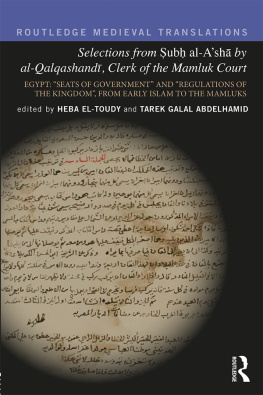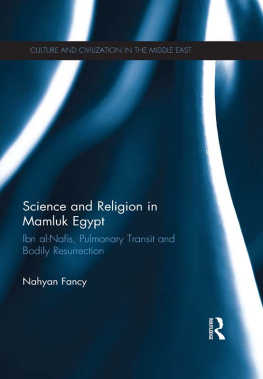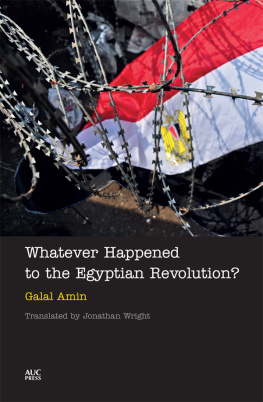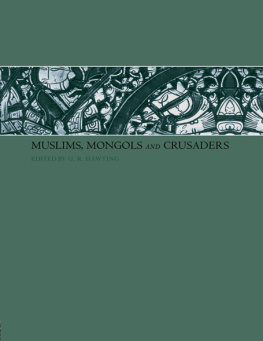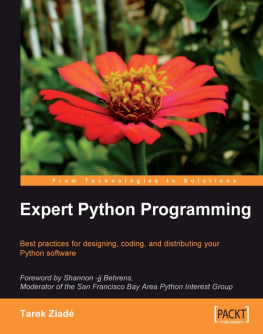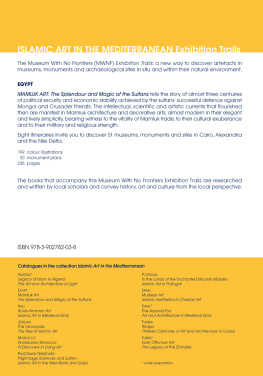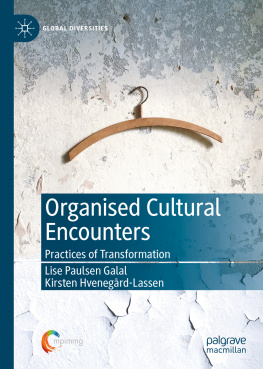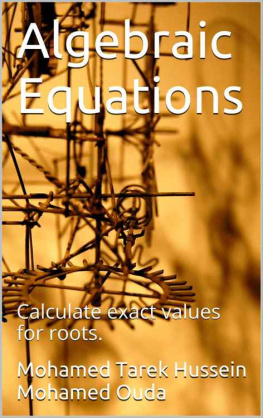p.i
SELECTIONS FROM UB AL-ASH BY AL-QALQASHAND, CLERK OF THE MAMLUK COURT
ub al-Ash by al-Qalqashand is a manual for chancery clerks completed in 1412 and a vital source of information on Fatimid and Mamluk Egypt which, for the first time, has been translated into English.
The text provides valuable insight into the Mamluk and earlier Muslim eras. The selections presented in this volume describe Cairo, Fustat and the Cairo Citadel and give a detailed picture of the Fatimid ( AD 9691172), Ayyubid ( AD 1172-1250) and Mamluk ( AD 12501412) court customs, rituals and protocols, and depict how the Mamluk Sultanate was ruled. It also contains a wealth of details covering the geography, history and state administration systems of medieval Egypt. An introduction preceding the translation contextualizes al-Qalqashands role and manuscript, as well as introducing the man himself, while detailed notes accompany the translation to explain and elaborate on the content of the material. The volume concludes with an extensive glossary of terms which forms a mini-encyclopaedia of the Fatimid and Mamluk periods.
This translation will be a valuable resource for any student of medieval Islamic history.
Heba El-Toudy is an independent researcher and translator.
Tarek Galal Abdelhamid is an assistant professor of architecture at MSA University, Egypt. His previous publications include The Mamluk Army (2013), War In the Mamluk Period (2013), A Concise History of North Syria in the Mamluk Period (2013) and Lectures on Computer Applications in Archaeology (2014, 2015).
p.ii
ROUTLEDGE MEDIEVAL TRANSLATIONS
In the same series:
Guta Law and Guta Saga edited by Christine I. Peel
The Danish Medieval Laws edited by Ditlev Tamm and Helle Vogt
Selections from ub al-Ash by al-Qalqashand, Clerk of the Mamluk Court translated and edited by Heba El-Toudy, revised and edited by Tarek Galal Abdelhamid.
p.iii
SELECTIONS FROM
UB AL-ASH BY
AL-QALQASHAND,
CLERK OF THE
MAMLUK COURT
Egypt: Seats of Government and
Regulations of the Kingdom, From
Early Islam to the Mamluks
Edited by Heba El-Toudy
and Tarek Galal Abdelhamid
p.iv
First published 2017
by Routledge
2 Park Square, Milton Park, Abingdon, Oxon OX14 4RN
and by Routledge
711 Third Avenue, New York, NY 10017
Routledge is an imprint of the Taylor & Francis Group, an informa business
2017 Tarek Galal Abdelhamid and Heba El-Toudy
The right of the editors to be identified as the authors of the editorial material, and of the authors for their individual chapters, has been asserted in accordance with sections 77 and 78 of the Copyright, Designs and Patents Act 1988.
All rights reserved. No part of this book may be reprinted or reproduced or utilised in any form or by any electronic, mechanical, or other means, now known or hereafter invented, including photocopying and recording, or in any information storage or retrieval system, without permission in writing from the publishers.
Trademark notice: Product or corporate names may be trademarks or registered trademarks, and are used only for identification and explanation without intent to infringe.
British Library Cataloguing-in-Publication Data
A catalogue record for this book is available from the British Library
Library of Congress Cataloging-in-Publication Data
A catalog record for this book has been requested
ISBN: 978-1-138-66993-2 (hbk)
ISBN: 978-1-315-40526-1 (ebk)
Typeset in Times New Roman
by Swales & Willis Ltd, Exeter, Devon, UK
p.1
ub al-Ash (Morning of the Nightblind), Kitab ub al-Ash (Book of the Morning of the Nightblind) ub al-Ash f inat al-Insh (Morning of the Nightblind on the Craft of Composition), ub al-Ash f Kitbat al-Insh (Morning of the Nightblind on the Writing of Compositions) are among the variant names of this colossal fifteenth-century work by a renowned Egyptian clerk of the Mamluk court, al-Qalqashand. The book is a manual for chancery clerks, or official scribes, providing them with the various composition formulae required for their work, covering numerous topics on the principles, needs, skills and necessary knowledge for proper composition. Although the linguistic, literary and calligraphic aspects of writing take up a considerable proportion of the work; necessarily, and luckily for all medieval scholars, it also contains a wealth of information covering the geography, history and state administration systems of Egypt, Syria and other Muslim lands. This information was deemed part of the basic knowledge necessary for those working in the Chancery Bureau (dwn al-insh). This translation specifically selects several segments related to Egypt which give us a wealth of information especially on the Mamluk period, the era which the author witnessed. The selected segments also contain information that covers earlier historical eras dating back to the Islamic conquest of Egypt, with elaborate details especially of the Fatimid period.
The importance of this book comes from the fact that it is written by al-Qalqashand ( ah 756820/ ad 13551418), an experienced and esteemed official scribe in the Chancery Bureau, the official bureau for all state correspondence in the court of the Mamluk sultans al- ahir Barquq and his son al-Nair Farag. Due to his position and long appointment to the chancery, al-Qalqashand had great experience and knowledge of the workings of government, protocol, treaties and the other intricacies of the Mamluk state. He was a scholar, educated to the highest standards of jurisprudence in his time. He was once a judge with an untarnished reputation, so we may expect his account and information to be unbiased and truthful. He was also a creative author and poet, with great mastery of the Arabic language, and was appointed to the job partly because of a mandatory requirement for the post: eloquence. With the documents he composed, he was the official voice of the Mamluk state, the official voice of the sultan and, through his scribes, he saw and recorded all decrees, treaties, monetary transactions, bequests, gifts and whatever documents were produced or passed through formal government. His reputation as a pious and honourable man adds great credibility to his testimony. His account is that of an actual eyewitness and active participant at all levels of government, which should be of the highest value due to its accuracy by one of the most honourable, educated, eloquent and learned men of his time.
p.2
What isal-Insh?
Al-insh, al-insh (literary composition) or kitabat al-insh (writing texts or writing literary compositions) is a term used to refer to all tasks of construction or composition of documents in prose for the workings of the state, that is composition of letters, state-related documents and correspondence. All types of documents created in prose fall under this heading. The task of writing was considered by al-Qalqashand to be of two main types: composition of texts (kitbat al-insh) and accounting (kitbat al-amwl). He gave greater importance to the task of composition, or prose, than to accounting or even poetry and considered that those who are assigned to that task, the scribes, had to be necessarily more educated and eloquent than others to be able to fulfil their tasks. The term was also used to designate a type of literature which is basically manuals for scribes on how to do their tasks, with sample letters and documents that can be used as models for their work.

